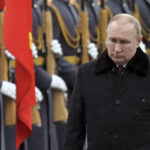KYIV, Ukraine (AP) — Russia began evacuating its embassy in Kyiv, and Ukraine urged its citizens to leave Russia on Wednesday as the region braced for further confrontation after President Vladimir Putin received authorization to use military force outside his country and the West responded with sanctions.
Hopes for a diplomatic way out of a new, potentially devastating war in Europe appeared all but sunk as the U.S. and key European allies accused Moscow on Tuesday of crossing a red line in rolling over Ukraine’s border into separatist regions — with some calling it an invasion.
Russia began pulling personnel from its diplomatic posts in Ukraine, state news agency Tass reported, a day after the Foreign Ministry announced a plan to evacuate, citing threats. By Wednesday afternoon, the Russian flag was no longer flying over the embassy in Kyiv, according to an Associated Press photographer. Police surrounded the building.
After weeks of trying to project calm, Ukrainian authorities also signaled increasing concern on Wednesday. The Foreign Ministry advised against travel to Russia and recommended anyone there leave immediately, saying Moscow’s “aggression” could lead to a significant reduction in consular services.
The head of Ukraine’s National Security and Defense Council called for a nationwide state of emergency — subject to parliamentary approval. Oleksiy Danilov said it will be up to regional authorities to determine which measures to apply, but they could include additional protection for public facilities, restrictions on traffic, and additional transport and document checks.
It was just the latest in a series of signs of escalating tensions. Kyiv recalled its ambassador to Russia and considered breaking all diplomatic ties with Moscow; Russia said it would evacuate personnel from its embassy in Ukraine; dozens of nations further squeezed Russian oligarchs and banks out of international markets; Germany halted a lucrative pipeline deal; the U.S. repositioned additional troops to NATO’s eastern flank bordering Russia; and the top U.S. diplomat canceled a meeting with his Russian counterpart.
Already, the threat of war has shredded Ukraine’s economy and raised the specter of massive casualties, energy shortages across Europe and global economic chaos.
Even as the conflict took a new, dangerous turn, leaders warned it could still get worse. Russian President Vladimir Putin has yet to unleash the force of the 150,000 troops massed on three sides of Ukraine, while U.S. President Joe Biden held back on even tougher sanctions that could cause economic turmoil for Russia but said they would go ahead if there is further aggression.
German Foreign Minister Annalena Baerbock on Wednesday called European Union sanctions agreed a day before just “a first step” and also said further measures could follow. Sanctions are key because the West has ruled out taking on Russia militarily.
Ukrainian Foreign Minister Dmytro Kuleba urged Western leaders not to wait.
“We call on partners to impose more sanctions on Russia now,” he wrote on Twitter on Wednesday. “Now the pressure needs to step up to stop Putin. Hit his economy and cronies. Hit more. Hit hard. Hit now.”
Responding defiantly to the steps already taken, Russian ambassador in the U.S. Anatoly Antonov retorted that “sanctions cannot solve a thing” in a statement on Facebook. “It is hard to imagine that there is a person in Washington who expects Russia to revise its foreign policy under a threat of restrictions.”
In Ukraine’s east, where an eight-year conflict between Russia-backed rebels and Ukrainian forces has killed nearly 14,000 people, violence also spiked again. One Ukrainian soldier was killed and six more sustained injuries after shelling by the rebels, Ukrainian military said. Separatist officials reported several explosions on their territory overnight and three civilian deaths.
Since last Friday, when separatist leaders in the Donetsk and Luhansk regions announced mass evacuations into Russia, more than 96,000 residents of the separatist areas have crossed the Russian border.
After weeks of rising tensions, Putin took a series of steps this week that dramatically raised the stakes. First, he recognized the independence of those separatist regions. Then, he said that recognition extends even to the large parts of the territories now held by Ukrainian forces, including the major Azov Sea port of Mariupol.
Finally, he asked for and was granted permission to use military force outside the country — effectively formalizing a Russian military deployment to the rebel regions.
Still, Putin suggested there was a way out of the crisis, laying out three conditions: He called on Kyiv to recognize Russia’s sovereignty over Crimea, the Black Sea peninsula that Moscow annexed from Ukraine in 2014, to renounce its bid to join NATO and partially demilitarize.
But it was unclear if there was actually any room for diplomacy since the first two demands had been previously rejected by Ukraine and the West as non-starters.
The Russian leader remained vague when asked whether he has sent any Russian troops into Ukraine and how far they could go, and separatist leader in Donetsk Denis Pushilin said Wednesday that there are currently no Russian troops in the region.
Pushilin’s remarks contradict those of Vladislav Brig, a member of the separatist local council in Donetsk, who told reporters Tuesday that Russian troops had already moved in. Late Monday, convoys of armored vehicles were seen rolling across the separatist-controlled territories. It wasn’t immediately clear if they were Russian.
___
Litvinova reported from Moscow. Jim Heintz in Kyiv; Angela Charlton in Paris; Frank Jordans in Berlin; Aamer Madhani, Eric Tucker, Ellen Knickmeyer, Robert Burns, Matthew Lee, Zeke Miller, Chris Megerian and Darlene Superville in Washington contributed to this report.
___
Follow AP’s coverage of the Ukraine crisis at https://apnews.com/hub/russia-ukraine




